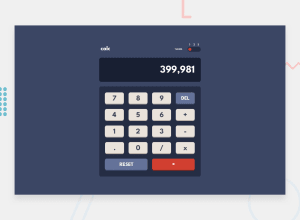
Design comparison
Solution retrospective
Some similar features are handled differently because I wanted to practice some skills. The most challenging part was to provide order of mathematical operations, for ex: 2+2*2=6 instead of 8. I handled this with an array of input because I also wanted to implement undo operation with 'DEL' button. It's clunky and heavy code but it works.
Community feedback
- @jebbaitedPosted 9 months ago
If you don't mind I'll leave some comments to your code.
1: Use Prettier to format code. It is much easier to read when formatted. Even with default settings.
2: Use error-first approach if possible when writing conditions. Your code:
function removeLastInput(){ if(input.length){ setInput(input.filter((el,i)=> input.length-1 !==i && el )) } }My code:
function removeLastInput() { if (!input.length) return setInput(input.filter((el, i) => input.length - 1 !== i && el)) } function replaceLastInput(value) { if (!input.length) return setInput(input.map((el, i) => (input.length - 1 !== i ? el : value))) }3: In switch/case construction you can use
returninstead ofbreak. Less rows in general.if (e.target.value) { switch (value) { case 'RESET': return setInput([]) case 'DEL': return removeLastInput() case '=': return calculateResult(concatNumbers()) default: setCharToInput(value) } }4: Variable creation. You could create an array in another way. Your code:
const firstArray = [...concatedNumbers] const secondArray = [] . . . firstArray.forEach((el) => el && secondArray.push(el))My code:
const firstArray = [...concatedNumbers] . . . const secondArray = firstArray.map((el) => el)Array.map() returns a new array and you don't need to push to another which you created above.
5: Some conditions difficult to understand and maintain. Like this one:
if ( previousInput === value || !previousInput || previousInput === '.' || isNaN(input[0] && isNaN(input[1])) || (isNaN(previousInput) && isNaN(input[input.length - 2]) && input.length >= 2) || (input.length === 1 && previousInput === '-') )Should be a good solution to create couple variables with good naming and then put them into this condition.
const notNaN = isNaN(input[0] && isNaN(input[1])) const someName = isNaN(previousInput) && isNaN(input[input.length - 2]) && input.length >= 2 if ( previousInput === value || !previousInput || previousInput === '.' || notNaN || someName || (input.length === 1 && previousInput === '-') )6: Try to not repeat similar components:
<Button>7</Button> <Button>8</Button> <Button>9</Button> <Button className="del">DEL</Button> <Button>4</Button> <Button>5</Button>Create an array and then go throught it.
const Buttons = [ { name: '7', }, { name: '8', }, { name: '9', }, { name: 'DEL', class: 'del', }, { name: '4', }, { name: '5', }, { name: '6', }, { name: '+', }, { name: '1', }, { name: '2', }, { name: '3', }, { name: '-', }, { name: '.', }, { name: '0', }, { name: '/', }, { name: 'x', }, { name: 'RESET', class: 'reset', }, { name: '=', class: 'equal', }, ] <Keyboard onClick={handleClick}> {Buttons.map((button) => ( <Button className={button.class ? button.class : ''}>{button.name}</Button> ))} </Keyboard>Also you don't need
<Keyboard />component. Just handle clicks on every button.<div className="kayboard"> {Buttons.map((button, index) => ( <Button className={button.class ? button.class : ''} onClick={handleClick} key={index}> {button.name} </Button> ))} </div>7: Let's change
<Button/>component a little bit.export default function Button({ name, className, onClick }) { return ( <button value={name} className={`button ${className}`} onClick={onClick}> {name} </button> ) }Now you can use without
childrenprops. Cause why do you need it if you pass only button name.<Button className={button.class ? button.class : ''} onClick={handleClick} name={button.name} key={index} />8:
ThreeStateToggle. Here we'll also avoid using same <input /> couple times. Create <Input /> component:const Input = forwardRef(function Input({ number, id, handleClick }, ref) { return ( <> <span>{number}</span> <input ref={ref} onClick={handleClick} className="toggle" type="radio" name="toggle" id={id} /> </> ) })Then use it:
const themeSwitchInputs = [ { number: 1, id: 'dark', ref: dark }, { number: 2, id: 'light', ref: light }, { number: 3, id: 'violet', ref: violet }, ] . . . <div className="tri-state-toggle"> {themeSwitchInputs.map((input) => ( <Input number={input.number} id={input.id} handleClick={handleClick} ref={input.ref} key={input.number} /> ))} </div>About
forwardRefread DOCSMarked as helpful1 - @lukKoteckiPosted 9 months ago
Than You very much for review. It's very helpful and enlightening.
-
done
-
fixed
-
fixed
-
leaved as it was because I'm not sure how to delete null indexes
-
fixed - even me when first written was scared of these conditions
-
fixed - I like this one
-
fixed
-
fixed -still not sure how it works but copy & paste helps
Once again Thank You!
0@jebbaitedPosted 9 months ago@lukKotecki 4.
const secondArray = firstArray.filter((el) => !!el) or const secondArray = firstArray.filter((el) => { if (el !== null) return el }) or const secondArray = firstArray.filter((el) => el && el)You are welcome!
Marked as helpful0 -
Please log in to post a comment
Log in with GitHubJoin our Discord community
Join thousands of Frontend Mentor community members taking the challenges, sharing resources, helping each other, and chatting about all things front-end!
Join our Discord
